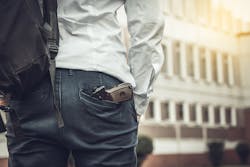Shootings, Stabbings, Suicide, Swatting and Recovered Weapons during the first few weeks of school
In just the first weeks of school, the national news has reported:
- a deadly school shooting at the Mergenthaler Vocational-Technical High School in Baltimore, Md.,
- a stabbing death at Northside High School in Jacksonville, N.C.,
- a suicide at Wendell Middle school in Wendell, N.C.,
- two individuals at T.W. Josey High School in Augusta, Ga. were wounded in a shooting outside the football stadium at the school's homecoming tailgate
- numerous other threats, hoaxes and recovered weapons on school campuses.
School administrators, public officials and law enforcement need to act immediately to prevent these incidents from happening. Until we seriously embrace a collaborative, proactive approach we will continue to see high numbers of deaths and injuries this school year.
Whether an attacker chooses to carry a gun, knife or other type of weapon, we must find ways to keep potentially lethal weapons off our school campuses. These violable incidents bring serious concerns and questions. Primarily, how do we strike a balance between education and security without making our schools resemble a prison?
Important Steps
According to data gathered by Education Week, there were 27 school shootings in the U.S. last school year, resulting in 27 deaths and 56 injuries.
Also, according to the Educator’s School Safety Network, 14 states have reported swatting incidents where individuals were making prank calls to emergency services in an attempt to bring about the dispatch of a large number of armed police officers to school campuses.
Before taking any action, one of the most important steps school administrators can take is to request a campus security review of their current risk assessment from a qualified school security expert who can help design a full plan for securing the entire campus.
Any plan will undoubtedly include technology, but no single technology can protect a school campus. True protection comes from many layers of security, ranging from locks to video intercoms to security screening systems that can help spot guns, knives, and other weapons.
A very effective plan that can be implemented is one that keeps students off balance or guessing what the security professionals have designed.
That plan includes random searches of student lockers (within legal restrictions) and the use of police K-9 units to sniff for weapons and drugs in and around buildings and in parking lots. By keeping the landscape well-trimmed, schools provide fewer hiding places for prohibited items.
Randomness of activities leaves students unsure of security measures and, therefore, many students decide it isn’t worth the risk of trying to sneak weapons onto the school campus.
Security screening systems are very useful for weapon screening in schools and other highly crowded charged atmospheres such as sporting events, school dances, and other large crowd activities.
Signs in the parking lots, at building entries and throughout the facility, declaring the campus a drug- and weapon-free zone, make it clear that violators will be suspended, expelled and/or prosecuted. An anonymous tip line or website can also allow students, staff, and parents to share rumors before they become reality.
Drills are Needed
While fire drills are mandated in virtually every school district, it’s equally important that schools practice active shooter (or slasher) drills. Admittedly, they take time away from classroom instruction, but these drills can save lives and prevent injuries.
Public address systems, phones, radios, duress buttons, fire alarms and other devices also can save lives during an emergency. Test them regularly to make sure they’re operational and working. Effective communication must be concise, quick, and clear messages are the key to effectively communicating in an emergency.
It’s also important to have school resource officers on a campus anytime staff and students are present. This can significantly trim police response time in emergencies when every second is critical.
And don’t forget surveillance cameras placed in and around school buildings.
Cameras have proven to be a strong deterrent and very effective in helping to ensure policies and procedures are being followed, as well as providing evidence in forensic situations. They also provide a critical live insight for first responders during an emergency.
School administrators, teachers, parents and even students need to be willing to make changes. But those need to be intelligent changes that make use of the proper technology, policies, and procedures – and even the element of surprise – to make our campuses safer and more secure.
About the Author

Patrick V. Fiel, Sr.
Former Executive Director of Security for Washington, D.C. Public Schools
Patrick V. Fiel Sr., a national security expert with more than 40 years of experience in law enforcement and security management, is a retired member of the U.S. Army Military Police Corps. He is available to speak on risk assessments, active shooter preparedness and security best practices. He can be reached at (910) 789-4265 or [email protected].
